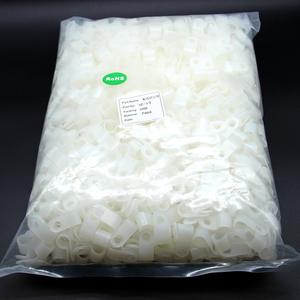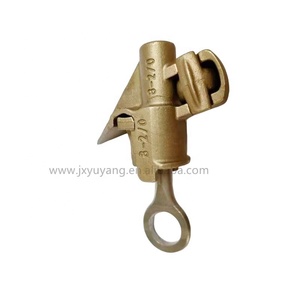
All categories
Featured selections
Trade Assurance
Buyer Central
Help Center
Get the app
Become a supplier

(4541 products available)



























Tap hot line clamps come in various types based on their specific applications. These types offset function, feature, and usage differences.
Here are the types of tap hot line clamps:
Standard line clamps
Standard line clamps are basic angled or straight-off fixtures for attaching to the main. These are often used for most general applications. These clamps feature a simple design with one or two hands, including partition keys or screws for secure mounting. In addition, they are compatible with various cable sizes and are widely used in many electrical systems.
Heavy-duty line clamps
Heavy-duty line clamps are designed to withstand extreme conditions. These conditions may include high temperatures, excessive vibrations, or exposure to corrosive elements. They are stronger and more durable than standard line clamps due to reinforced materials and enhanced gripping mechanisms. In addition, heavy-duty clamps are thicker, hence suitable for industrial and outdoor use where reliability is critical.
Insulated line clamps
Insulated line clamps incorporate protective coatings. These coatings help prevent electrical conductivity. This feature mitigates the risk of accidental short-circuiting or electrocution. Also, insulated line clamps are great for areas with high moisture or dust concentration. Here, insulation adds an extra safety layer and reduces the need for frequent maintenance.
Dual-sided impact clamps
Dual-sided impact clamps provide off-angled tapping on both sides of the clamp simultaneously. This unique feature makes them ideal for balanced load distribution in three-phase systems. These clamps are designed for easy installation, which minimizes operational disruptions during the tapping process.
Automatic line clamps
Automatic line clamps are equipped with self-tightening mechanisms. These mechanisms ensure a secure grip once positioned. This design not only enhances operational efficiency by reducing manual adjustments but also provides a consistent and firm hold. They are particularly advantageous in high-traffic environments where frequent application and removal are required.
Tap hot line clamps are critical in different electrical utilities and industrial settings. These circumstances require live line tapping without the need to shut down power.
Here are the industrial applications of taps hot line clamps:
Maintenance and repair in power plants
Power plants use tap-hotline clamps for the maintenance and repair of power transmission systems by tapping into live wires. These clamps allow quick repairs or system modifications without disrupting the ongoing power supply; hence, operational efficiency is maintained. In addition, having these clamps reduces downtime helps avoid the costly process of power shutdown; thus, these clamps are essential.
Upgrading electrical systems in industrial manufacturing plants
In a manufacturing plant, tap hot line clamps are used to facilitate an upgrade in electrical systems by providing additional circuits. This helps meet the increasing power demands of electrical equipment and machinery over time. They enable installing new power feeds without shutting down critical operations.
In connection to emergency backup generators
In hospitals, taps hot line clamps allow for the installation of emergency backup generators without power interruption. This maintains systems healthcare relies on, like ventilation, lighting, and life-support systems. These clamps enable the electrical teams to work efficiently under pressure, ensuring all essential services remain uninterrupted even during power outages.
In installation of street lighting
Tap hot line clamps are used in the utility industry to install or repair street and traffic lighting without killing electrical power to the lines on public road. This facilitates quick tapping, which helps keep the roads illuminated without power. Clamps here secure and reliable, ensure maintenance or upgrade of street lighting systems with minimal disruption to current.
For installation of new feeders in large commercial buildings
Hotline taps help HVAC systems, elevators, and lighting infrastructure by enabling the installation of new feeders. These clamps provide a safe and quick electrical work method in large commercial buildings. Emano scription, they help prevent downtime and power interruption.
Tap hot line clamps have different technical specifications and features that need to be understood for safe and effective application. The main clamp design integration has varied features that influence performance and compatibility.
Material composition
Tap hot line clamps are mainly aluminum or copper. These materials have great electrical conductivity and resistance to corrosion. Improper installation can have crippling effects; therefore, heat-treated aluminum provides extra strength while maintaining a lightweight profile for easier handling.
Safety Insulation
Most insulated line clamps have rubber or polymer insulations for a better grip. This reduces the risk of electrical accidents during live wire operation. They are also designed to meet electrical standards of safety, ensuring they can withstand extreme voltages.
Ergonomic design and size range
Ergonomic design alleviates fatigue during extended installations. Therefore, the size of hot line clamps varies. The size allows them to accommodate different conductor diameters, ranging from 6 mm to 20 mm, meeting various electrical system requirements.
Initial preparation
Initial clamp preparation involves ensuring a clean working space and having all the required tools ready. The clamps should get inspected for wear or damage before the installation.
Placement
After the inspection, the tap hot line clamp should be positioned appropriately. The tapping conductor of choice should be parallel with the main power line in in-line side.
Securing the clamp
To secure the clamp, the gripping dies should be closed around the tapping conductor by using a hydraulic crimping tool. Do not rush, as doing so risks snapping electrical lines or damaging the clamp.
Connection
The attached conductor is then connected to the electrical system by sealing or bolting the clamp onto the main power line. Proper torque application on bolts is important to avoid loosening, ensuring a secure connection.
Final check
Finally, after installation, the clamp should be visually checked to guarantee proper placement and secure fastening. Ensure all tools are retrieved from the work area to leave a safe work environment.
Visual inspection
Frequent visual inspections guarantee any indication of wear, corrosion, or damage gets detected early enough. Look out for cracks; they weaken the overall integrity of the clamp.
Cleaning
Debris, dust, or corrosion will reduce the functionality of the tap hot line clamps. This means cleaning regularly using non-abrasive materials that won't damage the clamp or its insulation is essential.
Check insulations
The insulation covers on insulated line clamps should be checked for cracks or deterioration. They will eventually reduce protective functionality. Further, they will need to be replaced if such happens.
Ensure proper storage
Hot line clamps are only to be stored in dry, low-heat, non-chemical-exposed areas. These factors will make the materials degrade faster than usual. Proper storage will prolong the clamp's life and reliability.
Test periodically
The clamps should be under periodic electrical load tests to check their current-carrying capacity. These tests will reveal any functional issues with the clamp under operating conditions.
Ensuring the quality of tap hot line clamps is critical to reliable electrical operations and safety. Various factors contribute to the overall safety and functionality of these tools.
Material strength and type
Quality hot line clamps are often made up of material that possess high tensile strength such as aluminum and copper. Such a feature ensures they can bear mechanical stress without snapping or deforming. Material type is equally important; copper has better electrical conductivity, while aluminum comes lighter and easier to install due to its heat-treated versions.
Corrosion resistance
Clamps in outdoor or harsh wet environment conditions should be coated or made of corrosion-resistant material. This guarantees their longevity and reliability. This is very important, as corrosion can severely weaken mechanical parts besides losing electrical conductivity.
Workmanship and design
The design of hot line clamps must ensure proper conductor grip, providing a great electrical connection and mechanical stability. Poor craftsmanship has irregular edges or poorly fitted parts that will create electrical arcing or line slippage.
Load capacity
High-quality clamps are rated for specific electrical loads or current-carrying capacities. This guarantees the clamp does not overheat or fail under extreme power conditions.
Regular inspections
To maintain safety, ensure hot line clamps get carried under frequent inspections to detect wear, such as bending or cracking. Failure to worn-out clamps can lead to mechanical disasters that cause electrocution or line failure.
Proper grounding
Ensure that near electrical work, there is grounding to prevent electrical shock. Proper grounding helps complete the electrical path to the ground, reducing hazards while working near live wires.
Personal protective equipment (PPE)
People have to put on PPE as required when carrying out electrical works, including insulated gloves and helmets. Insulated gloves help keep electric current from passing through a person's hands, while helmets protect the head from potential falling objects or electrocution.
Use properly rated tools
Ensure purpose-rated tools handle the voltage and current in the surrounding electrical environment. Non-rated tools can conduct electric current and likely result in electric shock or injury.
A1: Hot line clamps attach workmen on a live electrical line to do maintenance without switching off the current. They provide a temporary electrical connection with minimal power interruption so critical services will not be disrupted.
A2: Not all tap hot line clamps in design are universal. Some of their factors, such as conductor diameter and grip style, might make them compatible with a few other applications. This means that clamps designed for a specific application will perform better than multipurpose ones.
A3: The lifetime of hot line clamps varies with use and environment. It can be anywhere from three years if they are in extreme service conditions to fifteen years if they are in great service conditions. Regular inspections will help identify worn-out clamps and replace them early enough before failure occurs.
A4: Insulated style tap hot line clamps is a safety requirement for live linework. They will insulate the clamping area to prevent accidental electrical contact with the conductor. These uninsulated clamps should be isolated in areas of low voltage.
A5: Hot line clamps operate under various environmental conditions, such as extreme weather, corrosive saltwater, and dust. These factors affect the clamps' material, design, and features. Do regular maintenance and inspections to maintain reliability in the varied operating environment.